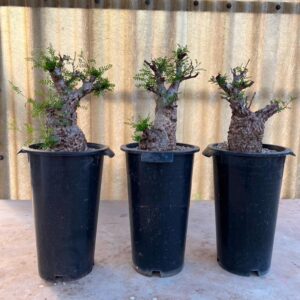Pachypodium baronii
Pachypodium baronii, commonly known as the Madagascar Palm or Bontaka, is a succulent plant belonging to the Apocynaceae family. It is endemic to the northwestern part of Madagascar, specifically from Befandriana Nord to Mandritsara.
-
: It is a robust shrub with a spherical or bottle-shaped trunk, typically 1 to 3.5 meters high.
-
: The trunk is 20 to 40 cm in diameter, narrowing at the top where it branches into several cylindrical stems.
-
: The bark is pale grey or grey-green and smooth, sometimes retaining leaf scars.
-
: The plant is covered in paired, curved spines that are red and pubescent when young, turning brown with age.
-
: Leaves are ovate and arranged in a bouquet.
-
: It produces spectacular red flowers, typically blooming from late spring to early summer.
-
: Found in open deciduous forests on calcareous rock, granite, or gneiss in western Madagascar at low elevations.
-
: Specific to the region from Befandriana Nord to Mandritsara.
-
: Seeds germinate within a month at temperatures between 22°C and 34°C.
-
: Suitable for warm climates, often grown as a succulent or bonsai plant.
-
: First described by Constantin and Bois in 1907
How to care for Pachypodium baronii
Caring for Pachypodium baronii involves understanding its specific needs regarding light, temperature, watering, and soil conditions. Here’s a comprehensive guide:
-
: Provide full sun to light shade. It is strongly phototropic and will bend towards the sun.
-
: Keep it in temperatures ranging from 12°C at night to up to 40°C during the day in the growing season. In winter, maintain a diurnal temperature of around 20°C and ensure the soil is dry to protect against cold damage.
-
: Water sparingly during the growing season (summer) to encourage new growth and flowering. Allow the soil to dry out completely between waterings.
-
: Keep the plant completely dry from late autumn to mid-spring to prevent rot and protect against cold temperatures.
-
: Use a gritty, porous cactus potting mix with a pH between 4 and 5. Include components like peat, gneiss sand, perlite, and vermiculite for optimal drainage12.
-
: Apply a balanced, water-soluble fertilizer during the active growth period to promote healthy growth and flowering.
-
: Prune only when necessary to maintain size or shape. The plant has excellent regenerative properties.
-
: Repot every 3 years, taking care to handle the spiny trunk by wrapping it in newspaper. Choose a larger pot if necessary to accommodate the growing caudex.
-
: Soak seeds in warm water for 24 hours before sowing in a well-draining medium. Maintain a temperature of 27–35°C for germination.
-
: Though less common, cuttings can be used but often fail to root. Allow them to dry for 5 to 8 days before potting.
-
: Protect the plant from frost as it is sensitive to cold temperatures.
-
: Handle with care due to sharp spines


Reviews
There are no reviews yet.